About Platelet Rich Fibrin (PRF) Treatment
Loss of collagen, elastin and hyaluronic acid all contribute to aging skin. With age the skin thins causing wrinkles, volume loss and laxity. Platelet Rich Fibrin (PRF) is a minimally invasive, fully autologous biomaterial that can be used to rejuvenate skin and restore lost hair.
Platelet rich fibrin (PRF) is a 100% natural product derived from your own blood. Platelets are rich in growth factors which signal stem cells to collect and differentiate at the site of injection. Growth factors are also important in stimulating the production of collagen, hyaluronic acid and new blood vessel growth which rejuvenates aging tissues. PRF spontaneously forms a fibrin matrix clot that traps secreted growth factors at the site of injection. Fibroblast cells are also recruited to the area which further stimulates collagen synthesis.
Your blood is drawn and centrifuged to separate its components according to their density. Red blood cells collect at the bottom of the tube with a small layer of white blood cells called the buffy coat above. Plasma forms the top layer where a high concentration of platelets resides. The plasma is drawn into a syringe and then injected into the area of treatment.
Platelet rich fibrin (PRF) offers all the benefits of platelet rich plasma (PRP), but it does not contain any additives such as anti-blood clotting products making it 100% natural. PRP depends on the body to activate platelets to form a clot after injection, or it can be induced to clot by additives that are combined with the PRP. This clot formation is essential to activate platelets to release growth factors for its anti aging benefits.
PRF has no anti-blood clotting products, so the platelets naturally form a fibrin scaffold that guides clot formation. This scaffold serves to support tissue regeneration and provides a localised, sustained release of growth factors and stem cells. With PRP growth factor release is rapid and short lived, limiting its long term benefit.
Lastly, growth factor concentrations have been found to be higher in PRF making it a more powerful tissue regenerating product.
Patients looking for an all natural, autologous product to rejuvenate, volumize, and restore aging tissues. Patients with under eye hollows, fine lines and wrinkles, skin laxity, stretch marks, textural and pigment irregularities can also benefit from PRF treatment. PRF is beneficial for patients suffering from loss of hair on their scalp and eyebrow areas and can improve the appearance of scars. It can also enhance the treatment outcomes if used with microneedling and non-ablative laser (ResurFX) treatment.
Certain medication and health conditions may alter the health of platelets which are the source of growth factors. Patients with blood diseases, are immunocompromised, have chronic liver conditions, are pregnant or breastfeeding should not undergo treatments. It is also not recommended if you are undergoing cancer treatments, have uncontrolled diabetes or have an infection of any kind.
Platelet rich fibrin (PRF) can be injected into the face and body. It provides a temporary volumizing effect which with repeated treatments leads to long term results from collagen production and localized regenerative activity. It can be injected into the scalp and eyebrow area to treat hair loss in those areas. It can be used to improve the appearance of scars and stretch marks anywhere on the body.
PRF can be heated to form a gel that can serve as a natural filler (Plasma gel). This can be used to volumize areas of the face and improve skin quality.
Although there are some mild volumizing effects immediately, skin quality improvement starts at 4 weeks and continues for several months. Hair growth begins at 8 weeks and continues for several months after your last treatment. It is recommended that you undergo a series of 3-5 treatments for best results.
There is minimal downtime after PRF procedures. There will be minimal pain during the blood draw and injection of the PRF. You may experience mild swelling, bruising or redness that will resolve in 3-4 days.
There is always a small chance of developing an infection or scarring in the treatment area which can be minimized by following all post care instructions. If PRF is inadvertently injected into a blood vessel tissue necrosis may occur.
- It is important that you arrive well hydrated to ensure an easy blood draw.
- You should not take any aspirin or anti inflammatory medication (ibuprofen, Advil, Aleve, Motrin), unless medically necessary, for 1 week before your treatment.
- Avoid any herbal supplements or vitamins such as vitamin E, fish oil, garlic, gingko, turmeric, ginger, ginseng, or St. John’s wort as they may affect platelet function.
- Avoid high impact exercise and excessive heat (hot tubs, saunas) for 48 hours to minimize swelling and bruising.
- Avoid massaging or rubbing the area or sleeping face down for 1 week.
- Makeup may be used on the area after 24 hours.
- You should avoid facials or facial massages for 3-4 weeks.
- Some rare complications such as tissue necrosis may not present for up to 3 days after treatment so travel should be avoided during this time to ensure access to proper treatment.
- Alcohol may affect healing and exacerbate swelling and bruising so should be avoided for 48 hours after treatment.
In general, if you are undergoing more than one treatment you should wait 2-4 weeks between treatments. For best results it is recommended that you undergo at least 3 treatment sessions.
